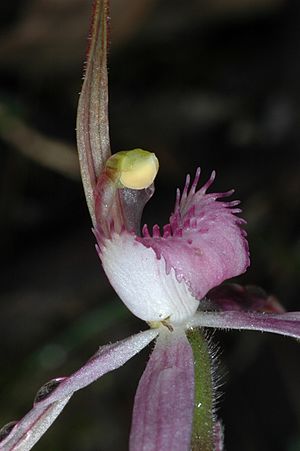Pink primrose orchid facts for kids
Quick facts for kids Pink primrose orchid |
|
|---|---|
 |
|
| Conservation status | |
| Scientific classification | |
| Genus: |
Caladenia
|
| Species: |
rosea
|
The Pink Primrose Orchid, officially known as Caladenia rosea, is a special type of orchid found only in a specific part of Western Australia. It grows in hard-to-reach, high areas that get a lot of rain. This orchid is a ground orchid, meaning it grows in the soil, not on other plants. It has one hairy leaf and can have up to three pretty pink flowers on a thin stem.
Caladenia rosea looks a bit like another orchid called Caladenia flava. However, you can tell it apart because its flowers are pink to dark pink. They also have clear red stripes and spots on the top sepal and side petals. Interestingly, this orchid acts like a mimic! It flowers at the same time as another plant, Hypocalymma robustum, and even has a similar color and smell.
Contents
What the Pink Primrose Orchid Looks Like
The Pink Primrose Orchid is a ground plant that lives for many years. It is a deciduous herb, which means its leaves die back each year. It grows from round tubers buried about 8 to 15 centimeters (3 to 6 inches) deep in the soil.
Each plant grows a single, hairy, long leaf. This leaf can be 5 to 15 centimeters (2 to 6 inches) long and 4 to 8 millimeters (0.16 to 0.31 inches) wide. It often has a purple tint, especially underneath, with darker purple veins.
Its Flowers
The Pink Primrose Orchid usually has up to three flowers. These flowers grow on a thin, slightly hairy stem that is 10 to 25 centimeters (4 to 10 inches) tall. There is also a small leaf-like part called a bract about halfway up the stem.
The sepals and petals of the flower spread out. They are entirely pink, often with deeper pink dots and stripes. The top sepal is shaped like a spear or egg and is 12 to 16 millimeters (0.47 to 0.63 inches) long. The side sepals are spoon-shaped or egg-shaped, and the petals are usually egg-shaped with one darker pink stripe.
The labellum (which is the orchid's special lip petal) has three clear lobes. It has a raised yellow plate near the base of the middle lobe. From this plate, rows of white bumps called calli extend outwards. The side lobes of the labellum are also pink. The entire labellum is about 4 to 5 millimeters (0.16 to 0.20 inches) long. The column, which is part of the flower's reproductive structure, is curved over the central plate and is yellow with noticeable white side wings.
Where the Pink Primrose Orchid Lives
Caladenia rosea grows in the same areas as another orchid, the Caladenia lateritica. They both prefer shallow, lateritic soil that sits on top of large bauxite deposits.
This orchid is found in open woodlands. The main trees in these areas are jarrah (Eucalyptus marginata) and marri (Corymbia calophylla). Below these trees, you can find other plants like Banksia sessilis, Conostylis setosa, Hypocalymma robustum, Orthosanthus laxus, Xanthorrhoea preissii, Phyllanthus calycinus, and different Stylidium species.
Ecology and Conservation
Scientists believe that Caladenia rosea mimics the flowers of the Swan River myrtle (Hypocalymma robustum). This means it looks and smells similar to the myrtle. We think that the same insects that pollinate the Swan River myrtle, probably native bees, also pollinate this orchid.
Just like the Caladenia lateritica, Caladenia rosea only grows in these specific shallow soils over bauxite. This area gets a lot of rain but is also being used for strip mining to get bauxite. Because of this, the Pink Primrose Orchid is considered a threatened species and is at risk of extinction.
Images for kids



